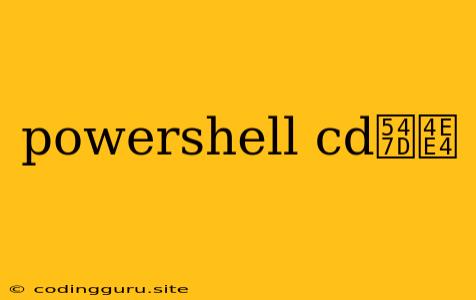Navigating Your Way Through Directories with the PowerShell CD Command
PowerShell is a powerful command-line shell and scripting language for Windows. One of the most basic and essential commands you'll use in PowerShell is the cd command, short for "Change Directory." This command is your key to moving around your file system, accessing different folders and files, and effectively managing your environment.
What is the cd command used for?
Imagine your computer's file system as a vast network of interconnected rooms, each room representing a directory. To navigate this network, you need a way to move between these rooms. The cd command provides you with this essential functionality. It allows you to:
- Change your current working directory: This is the location from which PowerShell executes commands.
- Access specific folders: You can directly navigate to any folder within your file system.
- Switch between different projects: This is especially handy when working on multiple projects simultaneously.
How to use the cd command
The cd command is straightforward to use. Here's the basic syntax:
cd [Path to directory]
Example:
To navigate to the Documents folder on your C drive, you would use:
cd C:\Users\[Your Username]\Documents
Key aspects of the cd command:
- Relative paths: You can use relative paths to navigate to folders that are located within your current working directory. For instance, if you're in the
C:\Users\[Your Username]directory and want to go to theDocumentsfolder, you can simply usecd Documents. - Parent directories: The special command
cd ..allows you to move one level up in the directory hierarchy. This is useful when you want to backtrack or move to a higher-level folder. - Home directory: The command
cdwith no argument will bring you back to your home directory, typicallyC:\Users\[Your Username]. - Special directories: PowerShell provides convenient shortcuts for common directories:
cd $env:temp: Navigates to the system's temporary directory.cd $env:systemroot: Takes you to the Windows system directory.
Tips for efficient directory navigation with cd:
- Tab completion: Use the Tab key to autocomplete directory names, making navigation faster and reducing typos.
dircommand: Thedircommand (orlsfor a Linux-like experience) is your companion to thecdcommand. It lists the contents of the current directory, allowing you to see what folders and files are available for you to navigate to.- Get-ChildItem cmdlet: This powerful cmdlet provides more comprehensive information about directories and files, including their properties, attributes, and permissions.
Combining cd with other PowerShell commands:
The cd command is often used in conjunction with other PowerShell commands to enhance their functionality. For example, you can use it to set the location for commands like Get-ChildItem, Set-Location, and even scripts.
In conclusion:
The cd command is an indispensable tool for navigating your file system in PowerShell. By mastering its simple syntax and incorporating it into your workflow, you'll gain a significant advantage in managing files, directories, and projects effectively. Whether you're a beginner or an experienced PowerShell user, the cd command remains a fundamental building block for efficient and productive PowerShell scripting.
